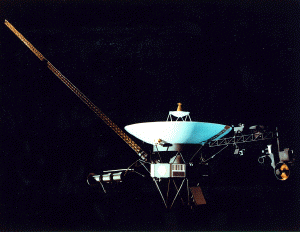
Voyager 1
NSSDC ID: 1977-084A
Telecommunications Description
Communications were provided through the high-gain antenna with a low-gain antenna for backup. The high-gain antenna supported both X-band (8.4 GHz) downlink science rates as high as 7.2 kbps and S-band (2.3 GHz) downlink rates as high as 40 bps. Voyager was the first spacecraft to utilize X-band as the primary telemetry link frequency. The transmitter power was 23 W. Data could be stored for later transmission to Earth through the use of an on-board digital tape recorder with a capacity for storing the equivalent of about 100 uncompressed images (roughly 500 million bits of data).
Ground support for Voyager was initially performed utilizing a combination of the 26 and 34 m antennae of the DSN for the early interplanetary cruise phase of the mission and the 64 m antennae supporting the higher telemetry rates during planetary encounter(s) (e.g., at Jupiter) and as the spacecraft exited the solar system. Upgrades were made in the DSN to replace the 64 m antennae with 70 m antennae, thus increasing the sensitivity of the DSN receiving stations and enabling a higher return of data.
Telemetry Path
Telemetry support via Deep Space Network (DSN)
Effective Telemetry
3.2 kbps
Telemetry Rates
0.01-115.2 kbps

